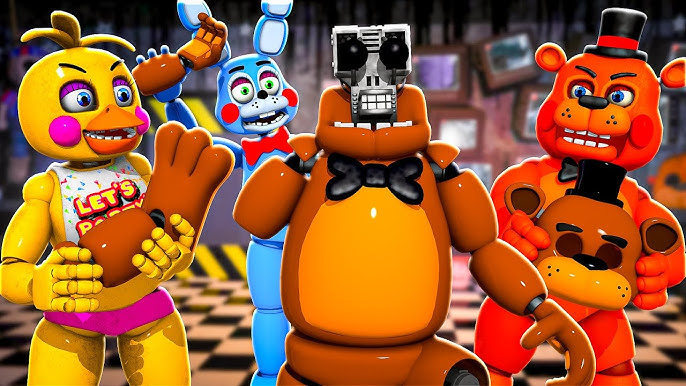Since the debut of Five Nights at Freddy’s (FNAF) in 2014, Freddy Fazbear has remained one of the most recognizable and central figures in modern horror gaming. Serving as the face of the franchise, Freddy is more than just an animatronic antagonist—he is a symbol of the twisted narrative that drives the entire series. As the games, books, and even film adaptations expanded, so too did the depth and complexity of Freddy’s role, making him a cornerstone of the FNAF universe.
Freddy’s influence within the FNAF story is not merely aesthetic or mechanical; it’s deeply narrative. As the leader of the animatronics and often the final threat in many of the series’ installments, Freddy represents both the surface-level horror and the deeper tragedy embedded in the FNAF lore. For fans and newcomers alike, exploring Freddy Fnaf helps to unravel the dark mythology behind the haunted pizzeria and the animatronics that stalk its halls.
Origins: A Mascot with a Sinister Legacy
Freddy Fazbear is modeled after a brown bear and serves as the frontman of Freddy Fazbear’s Pizza, a fictional restaurant modeled after real-life establishments like Chuck E. Cheese. On the surface, Freddy appears to be an innocent, family-friendly character. However, the game quickly reveals that beneath this cheerful facade lies a disturbing secret.
According to the lore, Freddy and the other animatronics are haunted by the spirits of murdered children. This haunting transforms them into hostile entities, programmed to roam the restaurant at night and attack security guards. Freddy, in particular, is notorious for his cunning and stealth, often hiding in the shadows and waiting until the last moment to strike.
Symbol of the Franchise’s Psychological Horror
What separates Freddy from typical horror antagonists is the psychological element he brings to the game. Unlike overtly violent or grotesque enemies in other horror franchises, Freddy’s terror stems from anticipation, atmosphere, and unpredictability. His haunting music box tune, flickering eyes, and sudden appearances emphasize dread over gore.
In later games, Freddy’s character evolved to reflect the changing tone of the series. In FNAF 2, he appears in a retrofitted “Toy Freddy” form, reflecting the franchise’s theme of technological upgrades hiding darker secrets. In FNAF 3 and beyond, different variations like “Phantom Freddy,” “Nightmare Freddy,” and “Glamrock Freddy” showcase how his character mirrors shifts in narrative and design philosophy, becoming more complex and layered with each installment.
Freddy as a Narrative Anchor
Freddy is not just a gameplay obstacle; he is central to the unfolding mystery of the FNAF universe. The lore surrounding the series is deeply rooted in themes of loss, vengeance, and corruption. Freddy represents the intersection between those themes—haunted by the past, driven by an unknown force, and ultimately a victim himself.
In many of the game’s hidden mini-games and secret endings, Freddy appears as a witness or participant in key events that shape the backstory. His presence often marks significant narrative turning points, linking the various timelines and story arcs. As theories about the Purple Guy, missing children, and the bite of ’87 circulated within the community, Freddy remained the focal point around which most of these theories revolved.
The Evolution of Freddy’s Image
Over the years, Freddy’s design has changed significantly to reflect evolving artistic direction and narrative tone. While early versions emphasized a rugged, mechanical look, recent iterations have embraced more detailed textures, emotional expressions, and even empathy. In FNAF: Security Breach, Glamrock Freddy becomes a surprisingly helpful character, assisting the player instead of hunting them. This role reversal shocked fans and redefined Freddy’s place in the narrative—no longer just a villain, but also a potential ally.
This duality—the ability to embody both menace and compassion—has added considerable depth to his character. It underscores the broader themes of redemption and broken innocence that have become more prominent in the later FNAF titles.
Why Freddy Remains the Face of FNAF
Despite the introduction of many other iconic characters like Bonnie, Chica, Foxy, and Springtrap, Freddy has remained the franchise’s centerpiece. His design is timeless, his presence haunting, and his story integral to the game’s central mystery. He is the link between the past and present, between horror and narrative.
Freddy’s adaptability has allowed the character to remain relevant through years of gameplay innovation and fan speculation. Whether as a lurking threat in the shadows or a surprising ally in neon lights, Freddy Fazbear continues to be a powerful symbol of everything that defines FNAF—fear, curiosity, and the unknown.
Conclusion
Freddy’s enduring role in the FNAF lore is a testament to his careful design and narrative depth. He is more than a jumpscare mechanic; he’s the beating heart of a franchise that thrives on mystery, suspense, and emotional storytelling. As the series continues to grow, Freddy will no doubt evolve again, remaining the centerpiece of a universe that has captivated millions.

